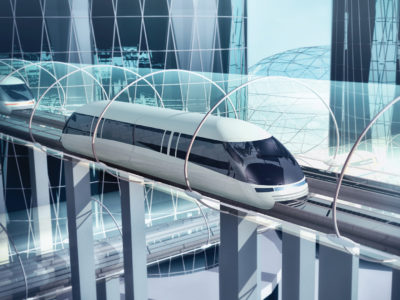Our current Transportation Grid is analogous to owning the car that drives upon it. Having invested so much, we feel obligated to keep it alive as long as possible; so we replace the tires, then the belts, the brakes, then the fuel pump, soon it’s the ignition, the alternator, the transmission, then wait a minute, for the price we paid to keep it running, we could have purchased a whole new car.
It’s that time. Let’s stop patching up the Transportation Grid, and just replace the whole damn thing.
All while we’re at it, this time let’s figure out how to:
- eliminate pollution
- minimize accidents (remember, We are all now footing the bill for this through Our New Health Care Taxes)
- minimize car theft (nearly 800,000 stolen cars a year? WTF)
- minimize congestion
- get smarter in how We use the new “roads”, so they last longer (i.e., get heavier vehicles onto their own “roads”)
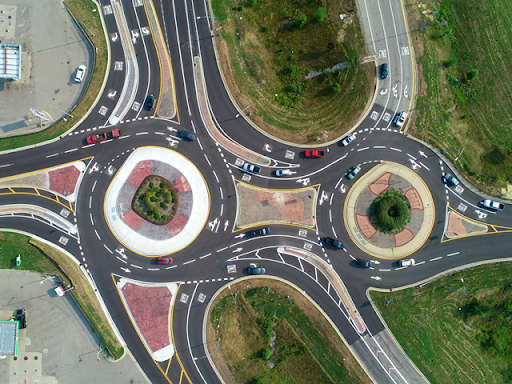
First Things First
How people transport themselves around is very tied to their notion of freedom and individual choice, and most certainly the character of each Community will be defined by the Transportation Grid they collectively ask Us to build for them. It is very likely that some citizens will even move into or out of a Community because they like or dislike the Transportation choices offered there.
Be assured that whatever variations are implemented, they will all be based on a common “National” theme:
- A new smaller vehicle with
• zero carbon emissions
• high-tech navigation, safety, and security systems
• the ability to travel on whatever futuristic type of “road” awaits it. - A strategy that attempts to
• lower traffic congestion
• lower accident rates between vehicles, pedestrians, emergency transport, and bicycles / micro mobility
• move big heavy vehicles away from the small vehicle space
• emphasize what is most important to each Community
Enter The Pod Car
[and the new Federal Ride-Sharing Grid where the Pod will travel]

There is an amazing amount of us (especially in the Urban sprawl of California) who drive our cars solo to work each day. Many of us like the autonomy of a vehicle designed for an individual, even when it causes us to sit in hours of congested traffic. Even devout Mass transit riders have recently jumped ship to use the newer ride-sharing offerings of Uber and Lyft.
Our first priority is to build a car for commuters that is not 25 times larger than the single driver that generally occupies it. Meanwhile, We will put it on its own road, and through a “ride sharing” strategy, limit the number of vehicles on this new “road”, so congestion is manageable. We will also separate it from possible collision with anything else and make it “driverless”, So commuters can spend less time cursing at their fellow citizens and focus instead on something more productive while they travel. And of course, we will make it electric and pollution free. More on this in a moment, but first:
Let’s use this moment to positively come together and share in the rebuilding of our Communities. What will your Community choose to emphasize when rebuilding its transportation grid? Will it embrace a futuristic theme, or perhaps get nostalgic, and encase Pod Cars with Old School American car chassis: corvettes, mustangs, model T’s, thunderbirds, etc. – perhaps your Community will pay homage to the bicycle, and build transportation around this mode of transit. Maybe your town likes walking, and will close down the center of town to any private vehicles. Maybe cold or inclement weather will prompt some Communities to choose a more sheltered mode of transit. Some may opt to put the roads up high, while others will place roads below the surface. Maybe your area will embrace micro-mobility, or moving sidewalks, or perhaps something that no one has even thought of yet.
Current Road Configuration
Imagine one of our larger residential roads, which often can measure 52 feet across. It is basically divided into four 13-foot spaces. The outside two 13-foot spaces are usually for parking (8 feet wide) and a designated bike lane (5 feet wide). The middle two 13-foot spaces are where vehicles drive.
NOTE: In contrast, one of the thinnest two-lane roads might measure only 36 feet across. It offers no bike lanes, 8 feet for parking on either side with two 10-foot lanes in the middle.
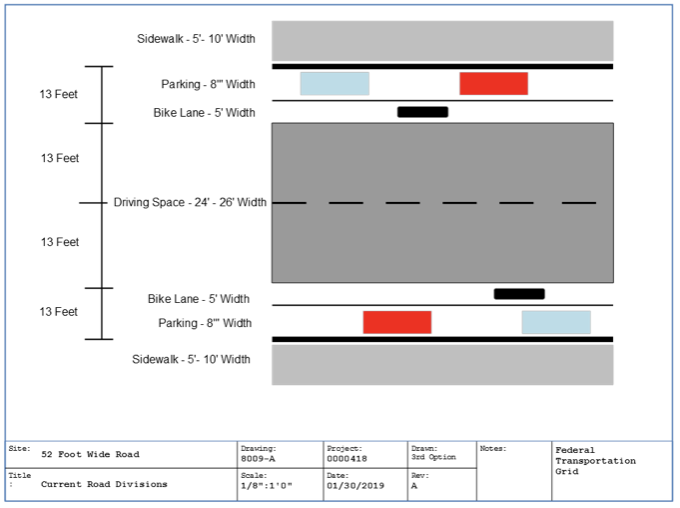
Let’s Get Specific
Pod cars could be anywhere from 3 feet wide to 5 feet wide, 5 or 6 feet long to 12 feet long, and hold one person, or as many as 6 people. People could sit facing each other or sit side by side. All seats could fold up or down to accommodate either people or cargo. As previously mentioned, the car itself cannot drive faster than 35 mph, but does have an attachment on the hood, in order to hook to new Magnetic Levitation Technology (Maglev) that will be available over freeways in order to speed people above the traffic at speeds up to 150 mph (but half that speed would be fine, too). It can be light and small because there is nothing for it to crash into. Like Uber or Lyft, you can hail it and tell it where to take you by using a phone app.
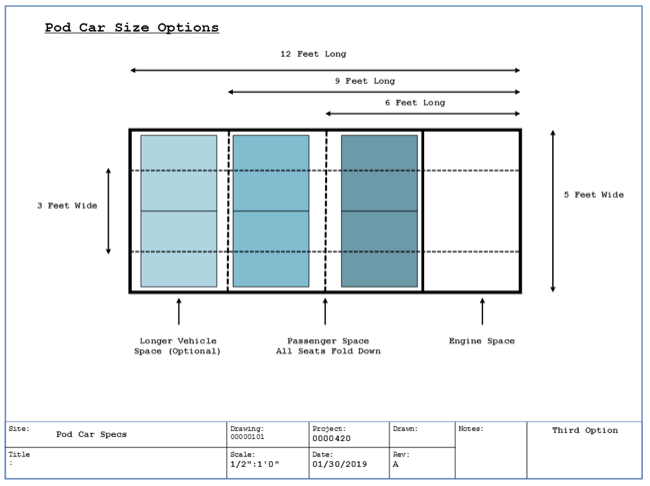
One Last Thing
At least four distinct groups of people move around on a busy street:
- Larger motorized vehicles of various kinds
- Bikes and scooters and the micro-mobility crowd
- People “on foot” [the walkers and joggers]
- Occasional Emergency vehicles.
At least four distinct groups of people move around on a busy street:
- Larger motorized vehicles of various kinds
- Bikes and scooters and the micro-mobility crowd
- People “on foot” [the walkers and joggers]
- Occasional Emergency vehicles.
None of these groups move at the same speed, or in the same direction, or follow the same rules. If you think about it, 6.3 million accidents a year is not that bad. It could be a lot worse.
Our Ride-sharing Pods will be helpful. Creating mixed Use Communities will be helpful. Possibly staggering the work hours of Our Federal Businesses could make a difference in morning commutes. Even so, We still need to offer a privately-owned vehicle option. This means We must figure out a way to separate them (and Emergency vehicles) from the more vulnerable forms of mobility. Because We want people to exercise, rather than discourage it, and We want Mixed Use Communities where people come together versus remaining isolated in their vehicles, it makes more sense to move the cars either up or down from the ground level.
New Ways To Use Community Road Space
Build a mini one-lane highway several feet off the ground, directly in the center of each road. This is where Our Federally owned Pod Car Ride-Sharing Business can operate. In the middle of every block, the one-way raised highway will flair out on both sides, creating a three [Pod] Car-length “pull out’ where our Uber-like vehicles can pull over to pick up and drop off passengers, or recharge their batteries when necessary. Users enter and exit the system by using the elevator or stairs located at ground level (in the space between sidewalk and curb).
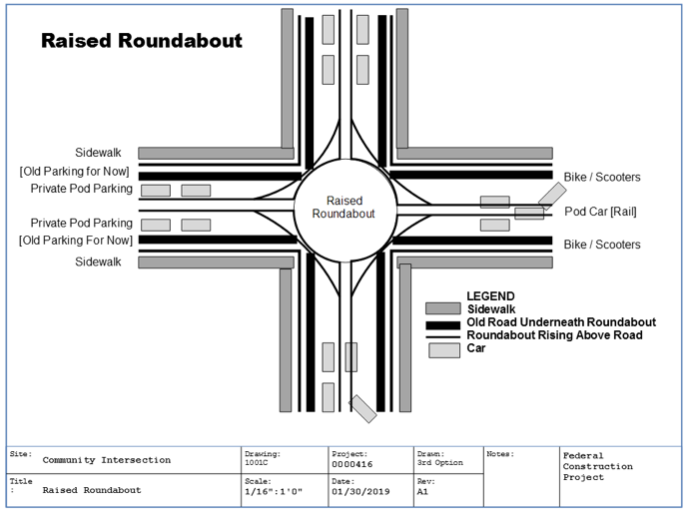
A short walkway connects elevators to the pull-out area where Our vehicles await. Raised Roundabouts are utilized at each intersection to keep Pod Cars moving along when either turning or continuing straight. Space for six vehicles (3 on each side of the road) will be available for recharging at night, or when they “intelligently” take themselves out of commission if their battery is running low. In order to prevent congestion, there will only be as many Pods operating as there are pull out charging stations available in the loop. Math suggests that at most 6,000 Pod Cars could service an entire population of 100,000 people.
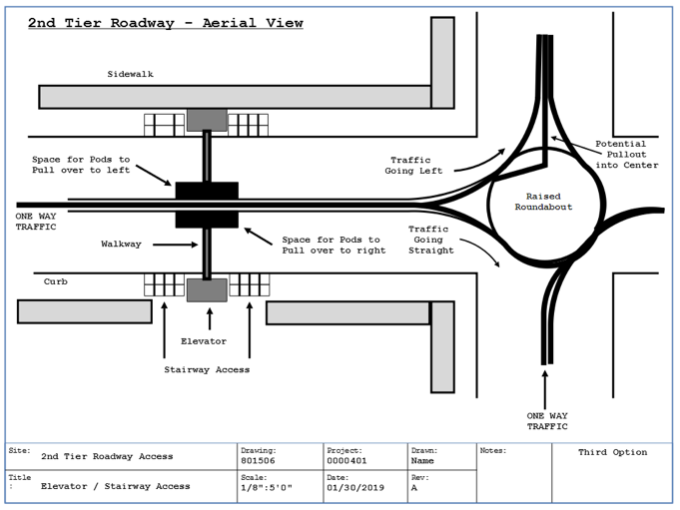
NOTES:
- These Pods can travel down off this raised road when a tune up or other service is needed. They can also enter a highway or freeway above the on-ramps, and using Maglev Technology located on the roof of the Pod Car, whiz by the traffic below and reach other nearby Communities. Although these “ride sharing” Pods will remain in some kind of closed “local” loop, privately owned Pods will be able to travel all over the United States. When traveling extreme distances, perhaps Pods can pull onto platforms, enabling them to be transported by rail or bullet train or “hyper-loop” technologies.
- Hyper-loop Technology really needs to travel straight (G-force issues), and Heavy Freight also needs to travel straight (rails last 2 years at the curves and 100 years at the “straightaways”. Conclusion: Freight and Hyper-loop are either stacked and go through the same tunnels, or Hyper-loop is our new rail system, and it handles all our freight and accommodates Pod Car platforms for quick travel times to distant places.
- One Emergency Vehicle option is to connect a direct second story entrance / exit ramp to the local Emergency Room, where AI technology can re-route the general ride-sharing traffic to allow a Pod quick access to the hospital, or even for emergency medical technicians [in their own Pod] to come out of the local Emergency Care and attend to and transport patients when needed.
- For this reason, the 2nd Tier pullouts [that already have room for 3 charging stations] will have an extra space for Emergency Vehicles (including police) to pull over, and another designated space for delivery, waste management, or other service vehicles to pull over (room for 5 vehicles total X 10 feet per = 50 Feet of space around walkways / elevator exits)
- When goods enter the country by ship or by airplane [then through Customs, to collect any Import taxes], they can be transported by hydrogen fuel-powered rail cars or by hyper loop technology to the outskirts of Communities, where our Federally owned shipping and delivery businesses can transport them to their final destinations. (Once morning commuters have vacated the ride-sharing grid, or even before commuters get started, perhaps the upper tier highway can be used for delivering of various goods, saving Us money on an extra fleet of delivery vehicles at the ground level).
- Package Delivery services already use Robotic bins on wheels that could exit Pods, roll down the walkway, fit in the elevator, where postal workers could still do their thing delivering packages at ground level, if a 2nd tier delivery service is a strategy that Communities wish to utilize.
- Cars parked at the curb cause visibility issues that lead to many accidents, including children darting out between cars and getting hit. Attempts are already being made to get parked cars off the road and into garages or driveways. Affordable Housing will help this along by allotting space for parking all owned vehicles off the road. An eventual law will ban owned vehicles from parking on the street, so be prepared.
NOTE:
- At least 8 feet of space on either side of the road will be opened up, and can be used for bikes and micro-mobility, or waste management, or delivery of larger goods.
- Yes, We will also manufacture Pod Cars for private ownership. The desire is that they can only reach speeds of 35 miles per hour on their own, unless attached to a maglev rail or hyper loop that can accelerate them further. If this is unacceptable to anyone, then AI technology will be used to disable the car’s ability to drive faster than the designated speed limit in all areas. This same technology could stop cars when Pedestrians trigger crosswalks by stepping onto a designated pad as they enter the road, or if necessary, be disabled momentarily when Emergency Vehicles pass.
NOTE:
- Your privately-owned Pod car will open by putting your hand on the door, and will not operate until you wish it “good morning” and it does a face-recognition scan. There will be no way to disable the vehicle from the outside, and once inside, if someone does not pass the voice and face recognition test, the car will lock the occupant inside and alert the police, who will Skype the driver and have a chat with them, in case there is some misunderstanding.
- Hopefully We will head toward a Pod Car that doesn’t use a “manual mode” at all, unless the Car loses its onboard energy or operating system. Only at this point would steering and braking be important, in which case bicycle pedals would be more useful than an accelerator pedal.
- If We continue to have vehicles move within the same space as pedestrians or micro-mobility, a rail system, while not as glamorous or high tech as a computer driven vehicle on an open road, nevertheless seems like a more fail-safe option.
- Freeways tend to congest in many cities between very specific destinations. To accommodate privately owned Pod Cars, We can build raised mini-highways that jump vehicles directly from one neighborhood to another, as an alternate route. Since cars would enter one at a time (with a slight delay), congestion along this route would be nonexistent. Maglev Technology could speed things even further.
- At the very heart of Communities, it is unclear why cars need to mingle with people at all. With ample parking supplied around the perimeter, and Uber-like Pods and micro-mobility made available, Community “centers” could not only shut out private vehicles for a few blocks in every direction, but even build lots of cool things in the space where those roads are no longer being utilized for transportation.
- As roads get torn up and replaced, Our new Communication, Water and Energy Grid can be installed, and sensors or rails or Energy-capturing Technology can be added [ See The Piesoelectric Effect]. It will be important to do this all at once to keep the costs down. An interesting idea: if everyone agrees to this 2nd Tier Ride-sharing Highway down the middle of every road, the four-foot-wide structural support needed at ground level might also be able to house an “above-ground” version of all of these utilities, which would instantly make it much easier to install Our utilities everywhere, and much easier to access it later for repairs or maintenance.
- Another Federal business venture that could be implemented near the new roads is Our Recyclable Plastic business, where customers pay for coffee cups or food / shipping containers, and receive a “credit” once these items are returned. Our grocery stores / shipping businesses / Coffee Shops will honor this “credit” and issue customers another “free” container the next time they make a purchase.
Two options (that are really the same option]. A “kiosk” or ATM-like set up exists near the stairs to the Ride-Sharing highway.
- Swipe a card, so the system recognizes you.
- Start scanning all Recyclable Plastic – the system acknowledges each item as it is placed in the proper opening.
- You get your “Credit”, and We get the plastic back.
Option 1: This “kiosk” is actually a Pod vehicle, and it’s at the top of the stairs, and it drives itself off at night when full and deposits everything at our Recycling Plant.
Option 2: the kiosk sits just off the Road at the bottom of the stairs, and all the waste products fall through tubes down into a sturdy metal Bin lowered into the road. The top of the Bin lies even with the road so cars can roll right over it, and rests on a powered “lift” several feet below the road. At night, a “Waste Vehicle” comes to get it. The vehicle hovers over the Bin, and the “lift” pushes it up into the hollow middle of the vehicle, takes it in, then replaces it with another empty Bin, and once that is lowered into place, the vehicle drives it to Our Recycling Plant.
This 2nd option might allow for all the trash to be collected at this spot in the middle of every block, as most people must take their trash out to the street anyway. With this method, it could be emptied every day if needed, and could probably be done robotically, or at least with minimal monitoring from some central station. Different openings for food waste, paper, plastic, etc., can help get the waste to the proper facility.
NOTE:
- It will be Our goal to outfit our Affordable Housing with second-story access (when possible) to this 2nd Tier Roadway, and some genius can figure how Our residents can sort trash right in or near their apartment, and off it can go in a Waste Collection Pod at night.
BOTTOM LINE: To manage all our waste, We need to Meet in the Middle and
a) make less of it
b) make it so it can all be reused, and
c) make it super easy for Us to get it where it can be recycled.
PARTING SHOT
Look out at the ridiculously complicated infrastructure We have talked ourselves into building in the name of the Car. The main point everyone can agree on is that whatever We choose to build, Our Engineers can make it happen. We just need a thoughtful vision of where to go next.
A Community “Center” as it might look now.
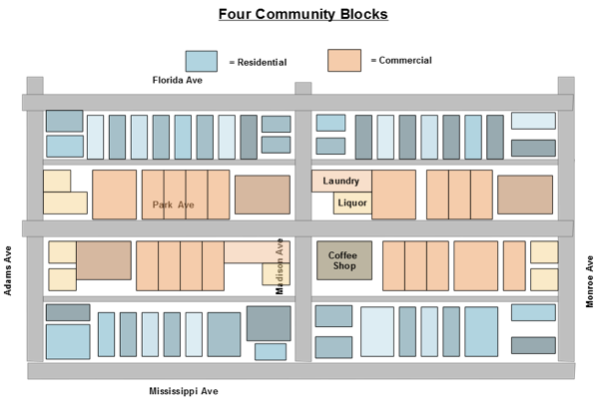
The same Community with a 2nd Tier Mini-Highway added.
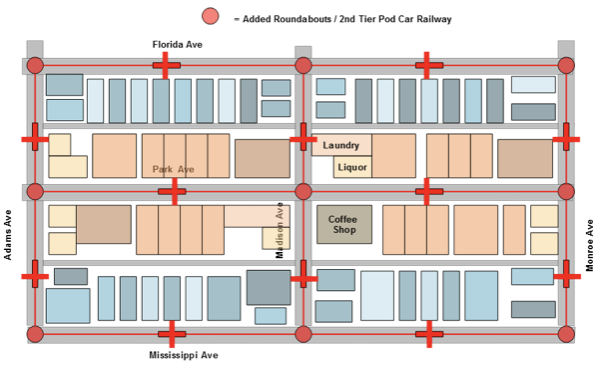
An option that closes off the “main drag” to privately owned vehicles, forcing people to walk or bike or take micro-mobility to get around. (Parking garages would be provided around the
perimeter, combined with ride-sharing options to enter the area). Notice how this gives Us the option to put Our Housing, Health Care and Community Center right where it belongs. [By the way, this particular neighborhood has horrible parking at night, so would benefit greatly from a better parking strategy].
Notice how the 2nd Tier Roadway could potentially drop people off directly inside the Hospital, Community Center, or Affordable Housing, meanwhile utilizing the buildings as support for the Roadway.
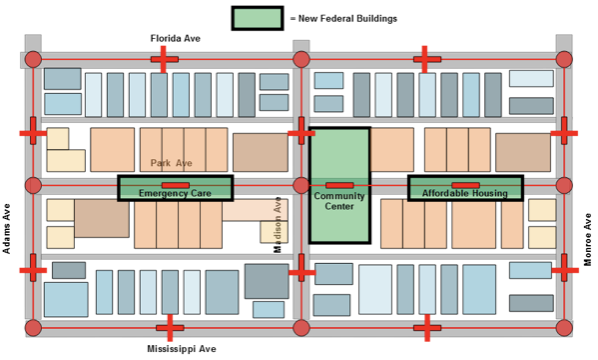
Other Noteworthy Projects
- Harness Electricity generated from the roads – Tiny watch-battery-sized sensors in the road can pick up electricity as cars pass by. We would bury thousands of them in newly paved roads, wired together. A one-and-a-half mile stretch of two-lane highway would generate enough electricity to power 1,000 homes.
- Transform the freeway “carpool” lane into a private Pod Car line instead. Two rails could fit in just one freeway lane, and could go in opposite directions or in the same direction. Calculations suggest that 50 times the number of Pods could travel on these two rails each hour compared to a regular freeway lane.
- Get rid of Our “un-recyclable” Plastic by putting in the new roads.
- There is no way in hell we are letting civilians fly around in drone-like vehicles (we are trying to eliminate accidents – not create even more), but perhaps if the technology improves, we could send drones out from roofs of our hospitals or fire stations or police stations to reach destinations very quickly, bypassing ground traffic.
- Finally, start Our own Federal Airlines using electricity-powered aircraft. We can start with short flights and small numbers of passengers. [Issue: we need lighter batteries that hold up to 10 times the capacity. Scientist Dr. Qichao Hu, [MIT] invented a polymer ionic liquid battery that can hold double the energy of a lithium-ion battery. “If we can make the batteries lighter, then we can increase the energy savings and flying range of airplanes.” Benefit: Electric Planes [like the Taurus G4, made by Slovenian airplane manufacturer Pipistrel] “need less runway to take off and climb faster than the same model that relies on fuel. And because electric planes are nearly silent, they have the potential to be flown and landed near dwellings and businesses.”. Another energy source: solar cells on the wings.
Comparing Transporation Strategies
PAYMENT PLAN A
We basically need 14 cents for every mile driven on US roads. * But heavier vehicles make more damage than lighter ones, so to be fair, we must charge cars based on their weight. Remember, a car twice as heavy actually causes 16 times the damage to the road. If we followed this math too strictly, however, We would all end up paying for it anyway (or doing without many things), as Mass transit and Fire Trucks and School Buses and Food and Beverage Delivery and really everything heavy out driving around is doing it to service Us. And when We charge that Delivery Truck or Uber 14 cents a mile, they are going to make you pay for it anyway, so really what is the point of getting too strict about it. Also, it is important to note that the bigger vehicles have professional drivers and rarely crash into things like the rest of us “lighter” vehicles.
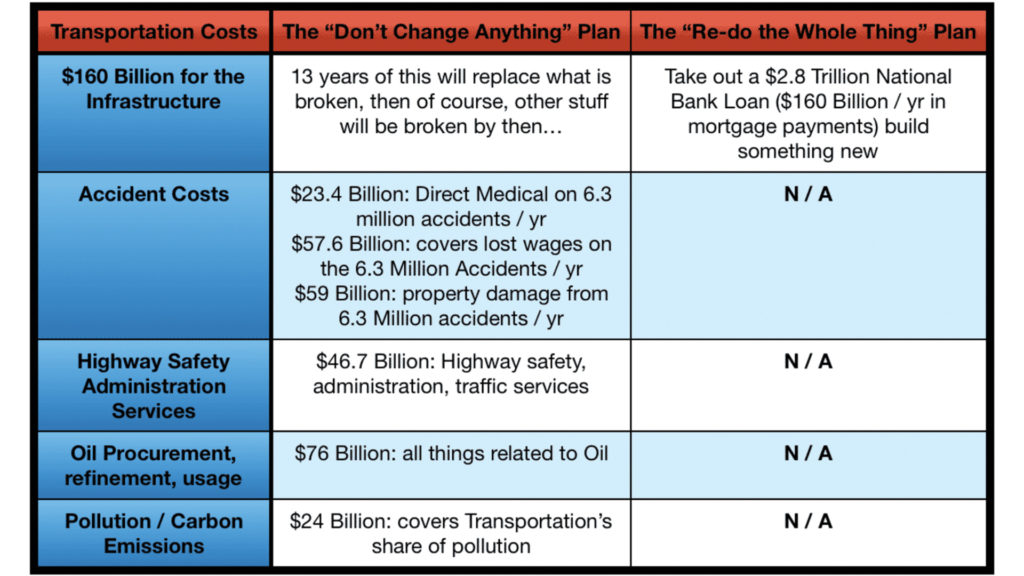
- Vehicles under 4,000 pounds pay 13 cents per mile
- Vehicles between 4,000 and 10,000 pounds pay 14 cents per mile
- Vehicles between 10,001and 20,000 pounds pay 15 cents per mile
- Vehicles between 20,001 and 33,000 pounds pay 16 cents per mile
- Vehicles over 33,000 pounds pay 17 cents per mile
*or every registered vehicle in the US (276.1 million of them) could pay $1,618 a year on their registration, and We wouldn’t need to count miles.
BOTTOM LINE:
- A 3,050-pound Prius driving 15,000 miles a year would pay $0.13 X 15,000 mi. or $1,950 on their registration.
- A 5,500-pound Chevy Tahoe driving 15,000 miles a year would pay $0.14 cents X 15,000 mi. or $2,100 on their registration.
This would of course lead to some irritating side effects, like people tampering with their odometers. Then We will have to devise some Cloud-based odometer-reader [called AUTOMATED MILEAGE REPORTING – in-vehicle technology, with or without general location data, that reports mileage traveled to a third party account manager who invoices the participant]. Another side effect would be mechanics trying to gouge us [people cannot help padding the bill when it goes to the Federal Government], to which We would have to create our Own Federal Mechanic and Body Shops, and give ourselves the money We have collected in order to fix up the cars we wreck (not necessarily a bad thing, as We are sure to charge ourselves less for repairs than the current rate).
PAYMENT PLAN B
For a $160 Billion a year payment, We can make ourselves $2.8 Trillion worth of something. This something would cost us a maximum 5 cents a mile (added to every vehicle that moves on our new Grid), but because we cannot afford to default on this Bank Loan to ourselves, and because everyone benefits equally, at least in the Retirement Department, it might be safer to charge everyone around $500 each and just be done with it.
BOTTOM LINE:
Some people will still want Plan A. We will tax them for it at around 14 cents a mile, plus 32.9 cents per gallon of gas, while still requiring some form of car insurance for them. Meanwhile the rest of us will go forward with Plan B. We will use the Transportation Taxes from the Plan A “holdouts” to pay for part of the Bank Loan, because if We didn’t, there would be a good argument to cut them off from any of the later Retirement Benefits derived from it. Eventually the Plan A holdouts will probably make the transition, especially once We ban their gas-powered vehicles for good.
Even though the math majors in the group will correctly calculate that all of us will have to pay a lot more to do both Plans simultaneously, this is an area where We will probably have to Meet in the Middle. The trick will be to construct our Plan A-B Grid so that the “B” part of it can transition out later without any additional Cost to our children.
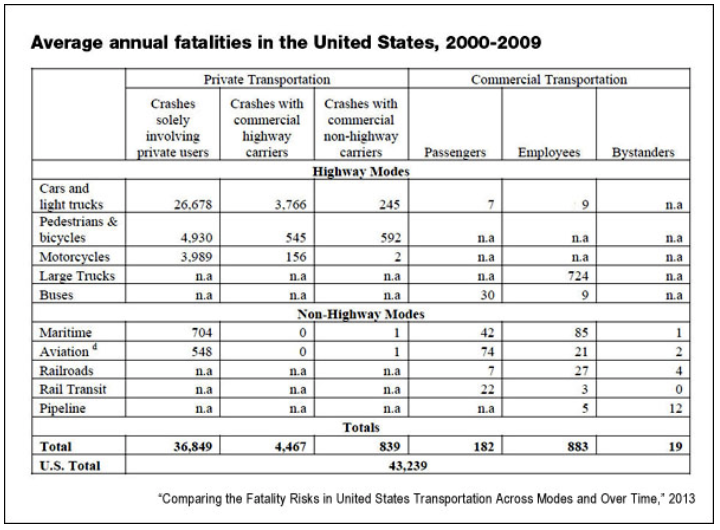
NOTES:
- Pedestrians die at night in the middle of the road between crosswalks (i.e., they are jaywalking, and often they and / or the driver of the car is drunk). They also tend to be elderly.
- Motorcyclists die as they pass on the left in an intersection, somehow not noticing the car in front of them is also turning left (deaths also occur as they squeeze between cars on the freeway)
- Bicyclists die in broad daylight at junctions and intersections (i.e., they have been known to enter the roadway without pausing at stop signs or red lights)
- The Micro-Mobility crowd die because they are in the road yet do not appear to know any of the rules of the road.
TAKEAWAYS
The more ‘safe’ we’ve tried to make the current system, the more lax everyone gets, and this laxness or ignorance of the rules of the road alone keeps the accident total at unacceptable levels. Either everyone needs to be trained to follow the same road rules, or some “fool” proof method must be implemented where cars are above or below everyone else [alcohol of course magnifies the problem exponentially. The driverless ride-Sharing Pods should help (if people utilize them), but a fully “driverless” scenario may eventually be needed].
WISH LIST
- Vehicles not contributing to Carbon Emissions (which means no oil industry refining it [$6.54 Billion], no citizens burning it [$46.2 Billion], no military procuring it [$12 Billion], no agency cleaning it up when it spills [BP oil spill cost $61.6 Billion]
- Vehicles not getting stolen or vandalized (777,000 vehicles stolen a year, or 237 for every 100,000 population)
- People not sitting in their going nowhere. Vehicles are designed to get us somewhere. This means We need a strategy to reduce congestion, but also one to reduce some of the constant stopping at every light or stop sign.
- Vehicles that are more affordable (According to The American Automobile Association, the average American spends $8,849 per year for “the privilege of driving” (not including the cost of parking). The U.S. Bureau of Labor Statistics calculates the average vehicle costs $9,576 per year to own and operate.
- Vehicle re-charging or re-fueling that is more convenient.
- Roads that last longer. The first strategy here is to remove heavier vehicles from asphalt roads. A 4,000-pound car leaves 16 times the damage of a 2,000-pound car. One of those big rigs does 410 times the damage of the 4,000-pound car.
- Whatever changes We make, let’s find a way to maintain the convenience experienced when owning one’s own vehicle. Vehicles that are “at the ready” when needed. Parking that is somehow assured. When needing to haul “stuff”, Our vehicles should be able to get as close as possible to where the “stuff” needs to go.
As always, if We are going to foot the bill for it, then We might as well actually own it. That way We get any money made from the use of it. Otherwise, it is another case of “pay for it, then rent to [not] own it”.
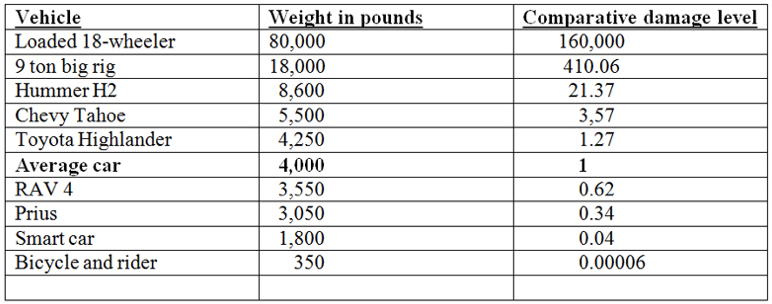
NUMBERS, NUMBERS
- Direct Medical Costs (Accidents) – $23.4 billion
- Lost workplace productivity cost = $57.6 Billion to $61 billion
- What is the value of a human life? Apparently $1.54 million per traffic death X 40,000 deaths per year, or $61.6 Billion
- Indirect Medical Costs (health-related issues):
- $24 Billion (asthma / heart attacks / premature pollution deaths)
- Road Costs – $160 Billion just to maintain, $836 Billion to completely fix
- Traffic Incident Management Cost (TIM)
- Police: 662,390 officers X $64,490 per officer (mean) = $42.72 Billion
- $17.8 billion a yearin highway patrol and safety
- [Estimated $100,000 per person in field]
Plus:
- $59 billion in property damage
- $12.9 billion inhighway and traffic services
- $16 billion in administrative costs (including planning and research)
- $12 Billion Minimum for our military to get Middle East oil to us
- Driver’s share of Carbon Emissions = $64 Billion from fuel use
The toughest and most important infrastructure decisions will need to be made in Transportation. Our current vision of transportation involves:
- lots of preventable deaths (42,000 each year when counting bikes and pedestrians)
- lots of preventable accidents (6.3 million recorded every year)
- lots of preventable pollution
- 177 Million Metric Tons a year to refine it, then another
- 1.82 Billion Metric Tons a year to burn it
- lots of preventable crimes
- 776,500 vehicles stolen a year
- lots of preventable Insurance
- most of us pay more than $1,300 a year (because cars crash, get stolen or vandalized)
According to The American Automobile Association, the average American spends $8,849 per year for the privilege of driving (not including the cost of parking). The U.S. Bureau of Labor Statistics calculates the average vehicle costs $9,576 per year to own and operate.
- Within that, $1,968 is spent on gasoline and motor oil expenses.
- Depending on who you ask, the average American spends between $900 and $1500 a year for Car Insurance
- Liability coverage – property damage or bodily injury you inflict on others
- Personal Injury Protection – harm you do to you or others in your car
- Collision Insurance – for damage done to your own car
- Comprehensive Insurance – if your car is stolen, damaged / vandalized when not driving it
- Uninsured / Underinsured Coverage – when the other party does not have insurance
- Gap Insurance – when your car is worth less than the amount you owed on it before it was stolen
OTHER NOTES
- We can reuse asphalt and concrete [grind it up].
- It is better to collect rain before it hits the ground, would our 2nd Tier collect rain, too?
- For every block of Community street We close down, We will need to provide at least 66 parking spaces somewhere on the perimeter.
- Supposedly Uber operators can drive 30 different people around in a 12-hour day [X 3000 cars gets 90,000 people a ride in a 100,000 population] *My calculation is 6% or 6000 cars to service 100,000 people
- We will let states figure out how to pay for highway and traffic services, Incident Management, patrol and safety costs, and administrative costs – You still have to pay for it, just not from us
- Current vehicles cannot exceed an 8-foot width (buses can be 8’ 6” in width) or be more than 14 feet in height
PROPOSAL: Vehicle Registration should continue to go to the state, but should only go to pay for highway patrol, DMV, other highway / road services, administrative costs of managing the roads within a state, even a portion to the Justice Department for highway related incidents. In other words, the states will have to pay for the management of the roads.
The cost of the roads now becomes a Federal concern. To collect the higher cost of $836 Billion to completely re-do the roads would likely cause everyone to poop their pants, so we will take the low “just cover up the potholes” cost of $160 Billion a year figure to start.
DILEMMA:
Road damage is a function of vehicle weight (which goes up exponentially [X to the 4th power, meaning a 200-pound vehicle does 16 times the damage of a 100 pound vehicle]
SOLUTION: heavier vehicles must pay more. This implies a Retail Tax on new vehicles based on weight / yearly tax on Vehicle Registration based on weight.
Road damage is also a function of whether you are actually using the road
SOLUTION: this implies an ODOMETER TAX, or a TOLL on road use, or an extra fuel tax.
There is also an argument that if we do not ALL pitch in for the roads, they will not be there when we need them.
SOLUTION: a yearly fee, most easily added to your vehicle registration
THE BASIC MATH:
276.1 million vehicles were registered in the US in 2018, and 3.2 Trillion Miles are Driven On U.S. Roads each year. However we slice up this $160 Billion dollar “bandaid” fix, each vehicle owner will need to chip in an average of $580 a year (in registration or further gas taxes) so our roads are tolerable. Then we can continue to crash all we want, run over bikers and pedestrians, get DUI’s and speeding tickets, and pay thousands to car insurance companies or out of pocket for the slightest dings to our vehicles.
IF WE KEEP THE CURRENT GRID BUT MAKE PEOPLE PAY THE TRUE COST OF IT
- Poor people drive more, because they cannot afford to live right where they have to work – so they will pay more.
- The heavier vehicles are buses, that poor people ride
- Big trucks, tractors, delivery, construction and fire trucks provide us valuable services.
Are we really going to slow ourselves down further by going through tolls, or spending money on cloud-based odometer-readers?
REALITY CHECK:
If We tacked the true cost of driving onto everyone’s registration, 90% of us would be forced to stop driving. So let us only pretend that We did this, then imagine everyone freaking out, which brings us to Plan B: rebuild transportation the way it should have been all along.
People who drive bigger vehicles would have to pay 2 to 4 times more, if we go down this road. If it guzzles more gas, and weighs more tons, be prepared to shoulder more cost. In reality though, the high percentage of these drivers need their trucks to do their jobs, or perhaps are mothers with several kids. Is this who we wish to financially punish?
INDIANA LAW [government can use the road for utilities or anything else, but only within the road space]
In determining how much of a landowner’s property is subject to a public right of way, where there has been no condemnation or grant which describes that right of way, Indiana’s court have consistently adopted a simple and straightforward rule. The public’s right of way, and thus the limits of any governmental entity’s permits given to utilities, is restricted to only that portion of the land which is “physically occupied by the road and no more.”
In Anderson v. City of Huntington, 40 Ind.App. 130, 81 N.E. 223 (1907) in addressing this issue the court stated “that the Huntington and Goshen road is a public highway, and was a public highway in front of appellant’s property prior to the action of the city of Huntington in establishing Jefferson street thereon, cannot be controverted. But its width and boundaries never having been established and determined by any competent authority, or recorded in any proper record, these boundaries must be determined by the use by the public. The wav cannot be greater than the use. Where the boundary lines of a road never have been established by any competent authority, but the right of the public to travel over such road has been established by continuous usage, the width of such road is determined by the width of such use.” McCreery v. Fallis (1904), 162 Ind. 255; Hart v. Trustees, etc. (1860). 15 Ind. 226: Board, etc., v. Huff 118831. 91 Ind. 333; Epler v. Niman (1854), 5 Ind. 459; Elliot, Roads and Sts. (2d ed ), §§376-386.
THINGS TO BUILD
- Pod Car Magnetic Levitation Rail (a la SkyTran) supposedly cost $13 Million a mile (roads are $25 million a lane / mile, Rail is $35 Million / mile)
- Roundabouts at intersections that are not super-congested are recommended by smart people.
- Add Sensors (to capture electricity), perhaps GPS (so no one can take out our Transportation Grid), and any other “Smart Technology directly into the roads
Functional Classification of US Roads
Interstate System — the highest classification of arterial roads and streets and provides the highest level of mobility, at the highest speed, for a long uninterrupted distance.
[46,334 Miles (1.2% of total distance), gets 23.9% of total usage]
FUNCTION: This is where Maglev or even Hyperloop Technology will be used, possibly heavy rail transport needed along some routes
Other Arterials — These consist of limited-access freeways, multi-lane highways, and other important highways supplementing the Interstate System that connect, as directly as practicable, the Nation’s principal urbanized areas, cities, and industrial centers; serve the national defense; and connect at suitable border points with routes of continental importance
[389,147 Miles (9.9% of total distance), gets 48.2% of total usage]
FUNCTION: Maglev Technology can help relieve congestion, but long term there may be cheaper solutions (using available space versus building new infrastructure). Main goal would be to keep traffic moving. Commuter biking would be a neat feature at some point.
Collectors — These provide both land access service and traffic circulation within residential neighborhoods, commercial and industrial areas, and downtown city centers. Collectors also connect local roads and streets with arterials and provide less mobility than arterials at lower speeds and for a shorter distance.
[794,701 Miles (20.3% of total distance), gets 14.8% of total usage]
FUNCTION: To Keep traffic moving, roundabouts can be built, freeing up safe space for non-vehicular traffic.
Locals — The local roads and streets provide a high level of access to abutting land but limited mobility.
[2,690,787 Miles (68.6% of total distance), gets 13.1% of total usage]
FUNCTION: Again, separation of people from vehicles.
Other interesting Urban Transit Designs: The Urbanist
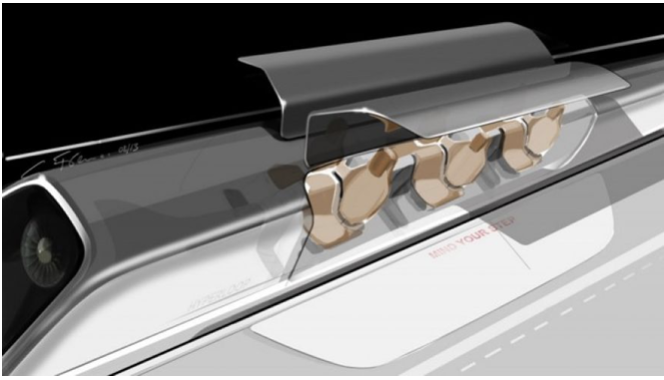
HYPER-LOOP
[From FoxNews.com ] – “One of the most exciting innovations in transportation has to be the Hyperloop train. Rising on nearly airless tubes at 800 mph, the train will transport you from LA to San Francisco in just 30 minutes. Elon Musk announced a design scheme back in August, but FoxNews.comhas learned the concept is more than a pipe dream — it is now a real technology in development.
“We’re moving toward conceptual design,” said Dr. Patricia Galloway, the co-leader of Hyperloop Transportation Technologies Inc., hinting at more than just a rough design sketch and an actual concept, something that is concrete and verifiable in the near future. “On paper, Hyperloop is both cheaper and quieter, and it is potentially much faster, than a maglev train,” said Rob Enderle, an analyst with Enderle Group who studies Silicon Valley technology. A ticket on the Hyperloop will cost just $20, according to Elon Musk’s math. The Tesla CEO tallies the total cost of the most advanced Hyperloop project at $7.5 billion. That’s for the passenger plus pedestrian version of the project. A passenger-only edition costs $6 billion. Musk says it will take 20 years to build. So here’s how he gets to $20: transporting 7.4 million people each way and amortizing the cost of $6 billion over 20 years gives a ticket price of $20 for a one-way trip for the passenger version of Hyperloop.”
SkyTran
(Tel Aviv, Israel) “ SkyTran will run on metal tracks six meters (20 ft) above the ground, although they won’t actually be “on” the tracks: The pod-like cars will hang below the tracks, floating along nearly friction-free thanks to maglev (magnetic levitation) technology…Passengers will be able to use a smartphone app to call a car to the nearest station (picture a staircase going up to a simple platform). Cars can run independently and will take riders as close to their destination as tracks allow. According to SkyTran’s CEO, Jerry Sanders, a SkyTran ride will cost a little more than a bus, but less than a comparable distance in a taxi. Additionally, once solar panels are installed, the SkyTran system will be energy neutral.”
Pic 15
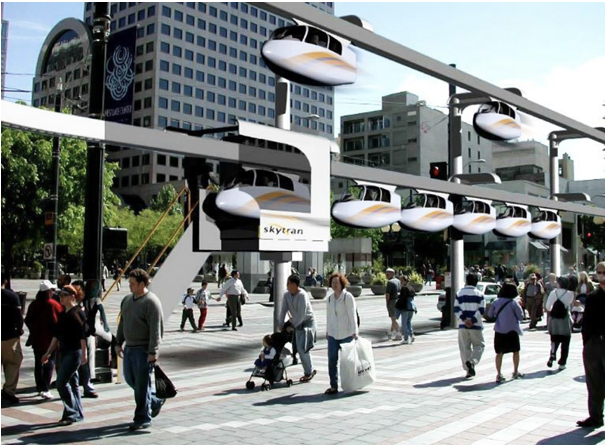
[SkyTran will be capable of speeds of up to 241 kilometers per hour (150 mph), but it will run slower, at least at first, “as riders get used to the idea”.]
NASA and SkyTran designed four different types of steel and aluminum pods: one that seats two people, one that seats four, one for the disabled, and one for larger cargo. The company says it will only cost about $13 million per mile to build, whereas a subway system can cost at least $160 million for the same distance.
MORE STUFF…
Elon Musk is boring underground. He is also tired of traffic congestion.

